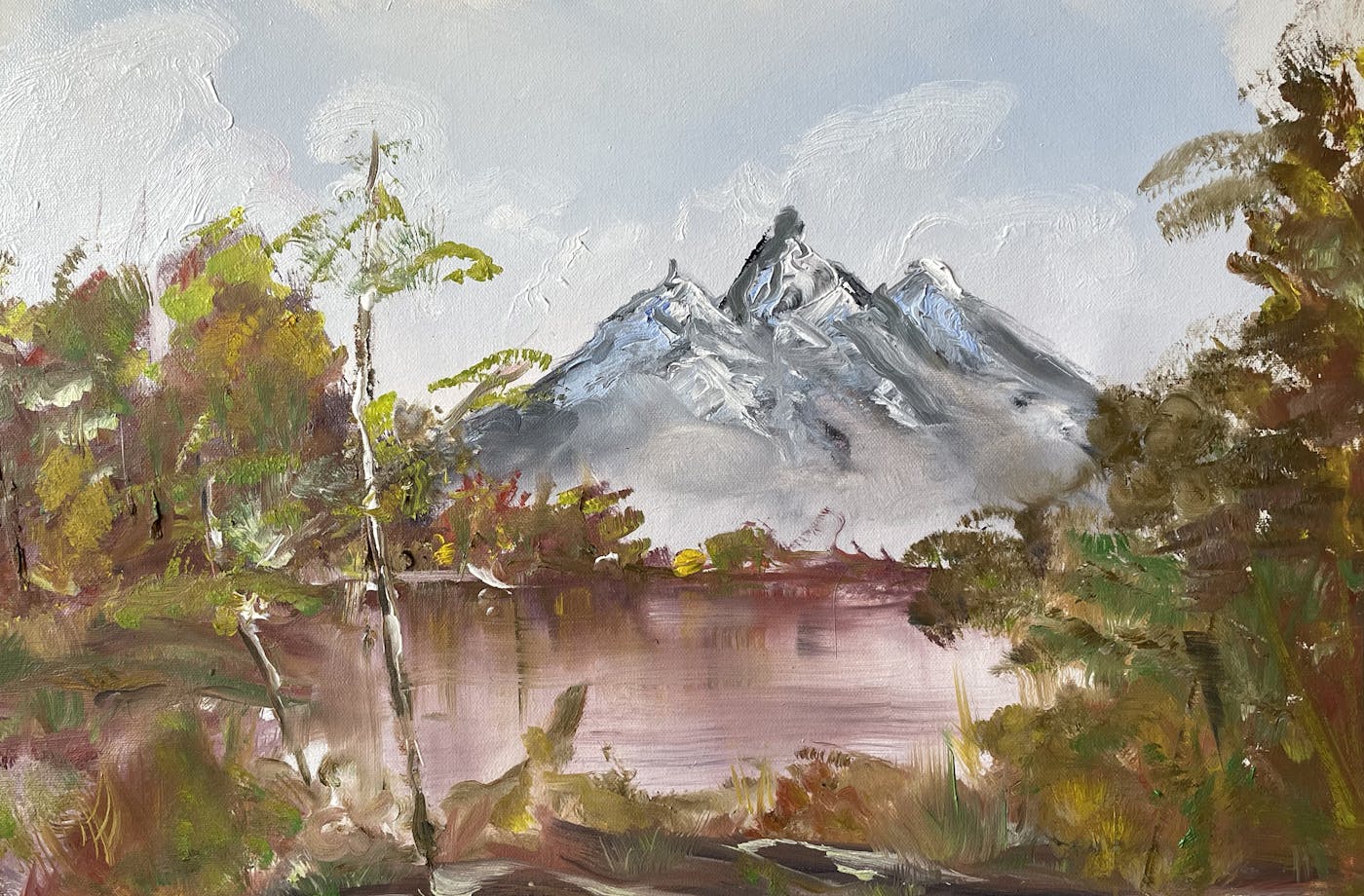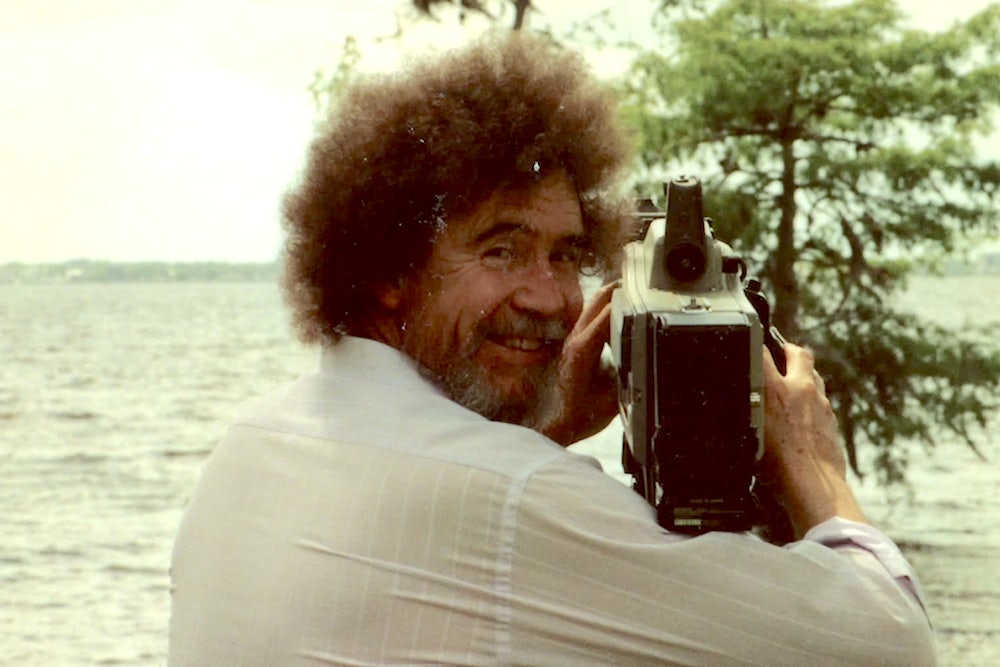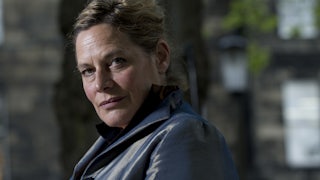Against a matte black backdrop, as if suspended in a starless void, a chestnut nimbus of hair says, “Glad you could join me today. I hope you’ve got your palette set up, and your almighty easel, and you’re ready to paint a beautiful painting with me.” I have neither of these things, but I do have a big rectangle of canvas pinned out before me on a board, some oil paint on a bit of an old cereal box, and a willing spirit. This is “Autumn Glory,” episode 11 of season 5 of The Joy of Painting, first broadcast on March 13, 1985, and I’m about to spend half an hour in the exalted company of Bob Ross.
I’ve selected this one at random from the 403 episodes of Ross’s how-to-paint show, which ran across 31 seasons, from 1983 to 1994, on noncommercial public TV stations in America. It was later syndicated across the world. In each episode, Ross creates a landscape painting in oils in 26 minutes, instructing the viewer on how to work along with him, speaking in a reassuringly low tone and frequently exhorting us to create a “happy little tree” or a “happy little cloud.” In one memorable season he introduces viewers to Peapod, a rescued infant squirrel who liked to sit in his pocket and watch proceedings.
The final product of “Autumn Glory” is supposed to show a glossy lake ringed by trees, a snow-capped mountain looming in the distance. It’s not what I’d usually choose. I grew up painting, which is probably why I’ve never even considered painting along to a Bob Ross show. For one thing, he always paints the same thing—vaguely Alaskan vistas of mountain ranges, streams, pine forests, and the odd barn. For another, he paints directly from his imagination, rather than in response to some real beauty found in the world, which I find bemusing and pointless.
Instead, it’s the emotional side of Bob Ross that draws me to him, particularly his fascination with happiness. Ross has a strong air of the 1970s about him, from his unvarying perm to his constant, hippie-style references to the happiness and fulfillment that painting can offer. Like the instruction manual The Joy of Sex (1972), whose title the show clearly references, The Joy of Painting was about demystifying the esoteric for ordinary people, empowering them with knowledge. “Talent is a pursued interest,” Ross says on one show. “In other words, anything you’re willing to practice, you can do.”
After watching the new Netflix documentary Bob Ross: Happy Accidents, Betrayal & Greed, painting an actual mountain seemed the only way to cut through the rancor swirling around the man himself. It centers on a conflict between Bob Ross Inc., the corporation founded by Ross’s business partners, and his own son, Steve. Bob Ross Inc. still uses his father’s nickname, “The Happy Painter,” on its art supply products, which makes the question of his father’s emotional state very relevant to the brand’s identity. According to Steve, despite the indomitable spirit of joy his father brought to the easel, the real Bob Ross was not happy at all.
I picked up a little Alizarin Crimson on my two-inch brush, as per Bob’s instructions, and began to make my mountain.
In order to paint like Bob Ross, one must use the Bob Ross technique. As the art historian Julia Friedman explains in the documentary, this is just another way of describing the very old technique of painting alla prima, “on the first try.” Painters of the Renaissance used it to render hair and cloth, and later the impressionists, such as Monet and Seurat, used it for everything. In this technique you cover the canvas first in a thin layer of wet paint and then apply new paint directly onto it.
Doing this lets you work extremely fast, as Bob Ross discovered when he saw Bill Alexander doing it on television in the 1970s. Ross had been in the Air Force for over a decade, including years stationed in remote Alaska, and he’d developed a passion for painting its wilderness in his spare time. But Alexander, the cheerful and German-accented host of PBS’s The Magic of Oil Painting, was finishing paintings before his eyes that would have taken him weeks.
When Ross retired from the military in 1981, he found Alexander in Florida and apprenticed with him, mastering the style. He began teaching workshops, then doing demonstrations in malls. By this time Ross had divorced his first wife, Steve’s mother, and met his beloved second wife, Jane Zanardelli. It was in a mall, the story goes, that they met Annette and Walt Kowalski, the couple who would become his business partners and help him turn his talent for encouraging people into one of the most influential art shows of all time.
The show was filmed at the Indiana studio of the PBS station WIPB, and Ross would record three shows a day. His style was a huge hit with viewers, which, according to his son, was the result of devoted practice. Since Bill Alexander spoke with a harsh German accent, Bob figured he would speak softly and gently. Where Alexander lectured as if to a packed hall, Bob speaks intimately, as if to one person. “It’s true,” Steve says: “He practiced being sexy.”
This combination of nonthreatening sex appeal and encouragement drew legions of fans to the Bob Ross altar. At public events, hundreds of people would turn up to show him their “work,” which of course was simply a duplication of his own.
Where did it all go wrong? The documentary strongly implies that Ross had an affair with Annette Kowalski and that its acrimonious end drove a wedge between the two couples who ran the business. Jane died quite suddenly of cancer in 1992, leaving Ross devastated. Then he was diagnosed with cancer.
As Ross weakened, Steve claims in the documentary, the Kowalskis pressured him to sign documents giving them exclusive rights to his name and image. He had wanted Steve to take over presenting the show, but Steve had shied away, in a classic rebellious move that he seems now to regret. On his deathbed, Steve says, Bob explained to him that Jane’s death had meant he had “lost a vote” on the direction of Bob Ross Inc. and felt that his own name was slipping out of his control. Steve feels that in the final stretch of Bob’s life (he died three years after Jane, in 1995), the Kowalskis kept him off television so that viewers would not realize he was ill, or later that he had died at all.
Steve calls the co-option of his father’s estate and legacy “shameful,” though it’s not clear exactly what he wants; the story feels more like a tragedy than an exposé, especially since without the Kowalskis there would have been no show. The Kowalskis have denied Steve’s accusations: In a statement to Vanity Fair, Bob Ross Inc. said, “If not for the efforts of the remaining founders and their dedication to this mission, Bob’s artistic and cultural relevance—and his expressed desire to become the world’s most beloved painting teacher and friend—would have been lost decades ago with his passing.” They have also already won the 2017 legal case around control of the Bob Ross brand, meaning Steve has no further recourse against them. “I think there’s an artist deep down inside every single one of us,” Bob Ross once said. Unfortunately, in his case, there was no accountant; he needed the Kowalskis as much as they needed him.
The documentary is frustratingly Neflixy, hitting the tropes of cut corners and power struggles over the much-missed dead common to so many of its investigative documentaries. We don’t get the Kowalskis’ side of the story, and although Steve Ross makes an impassioned case, the sad end of the Bob Ross story is just not as compelling as its joyful beginning and middle.
Bob Ross Inc. is now run by the Kowalskis’ daughter, Joan, and she’s clearly done a good job fostering his legacy in the internet age. There’s a culty little Rossiverse online, these days: Every Friday at noon E.T., Twitch streams weekend-long marathons of the show. His tutorials are the archetype for every YouTube “how-to” video, so it’s appropriate that he has his own channel there. The website FiveThirtyEight once conducted a statistical analysis of Bob Ross paintings. In what percentage of those paintings, the study asks, is a mountain covered with snow? “Given that Ross painted a mountain,” we learn, “there is a 66 percent chance there is snow on it.”
After a couple of tries at Autumn Glory, I’ve decided that Bob Ross’s show is not about paintings at all. Nobody wants 403 paintings of the Alaskan wilderness on their walls, after all. Bob Ross paintings have something of the romantic sublimity of the Hudson school of painting, crossed with the deliciously perfect gradients (pink shading into blue into white) of a boardwalk airbrushed T-shirt design. The final product he and I create together is the opposite of valuable, because it’s mass produced—just by hand, by volunteers instead of in a factory.


Ross offers something else: a totally peaceful and conflict-free vision of nature in a series of American pastoral images. In a Bob Ross painting, you are the gentle god of a world with no people in it, benevolent and skillful in your creations. Crucially, you and Bob are both in control. He speaks constantly on the show about being “the dictator” of the canvas, describing the scenes he paints as the “only place I’m really free.”
In the end, the joy of The Joy of Painting is in the act of following his instructions. What he teaches, essentially, is tricks and shortcuts: How to use a palette knife to apply paint in a way that replicates the effect of hundreds of tiny strokes; how to use objects like trees in the foreground to push back the scenes behind them. The process-based tutorial is now a huge genre, which millions of people participate in across the globe on YouTube and other social platforms. Seen in this light, the tutorial shift in culture, which transfers our attention from the final image to the process of creating the image (or dress, or makeup look, or drainage system, or whatever) makes Ross seem much more important than even his online cult status suggests.
When you master one of his little tricks, it does deliver an intense hit of satisfaction, a sense of an illusion pulled off. My Autumn Glory, unfortunately, is not quite there yet; I can’t seem to master the Ross effect of stippling leafy treetops onto wet paint. My paint has smeared where his is dappled, but the effect is quite nice, like a slightly blurred photocopy, and it’s not as if the original is much more creative. Along the way, I became irritated with Bob’s quick pace, then charmed by the gentle way that he predicted that frustration. Overall, the process of following his strict instructions is much more like writing an article for an assignment from an editor than taking a class: You cannot see how these little gestures are going to add up to anything, but if you trust the process it often works. I think my second attempt is marginally better than the first, so perhaps I did learn something.
Crucially, Bob Ross and YouTube tutorials sell a hobby, not a job; when you paint along to Bob Ross, or just watch him do it, it’s not work, but play—a kind of role-playing that relies on the fact that you’re almost certainly not a professional full-time painter if you’re actually painting along to the show. His tutorials, therefore, are like therapy sessions for the alienated and exhausted worker, whose labor is usually reserved for materially rewarding practices. The question of his own personal happiness as it related to his professional life feels almost beside the point; Bob Ross’s gift lay not in helping people make valuable art but in helping them find self-worth in their leisure time—not at work, and not through money, but in happy little worlds of one’s own creation.








